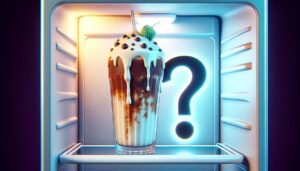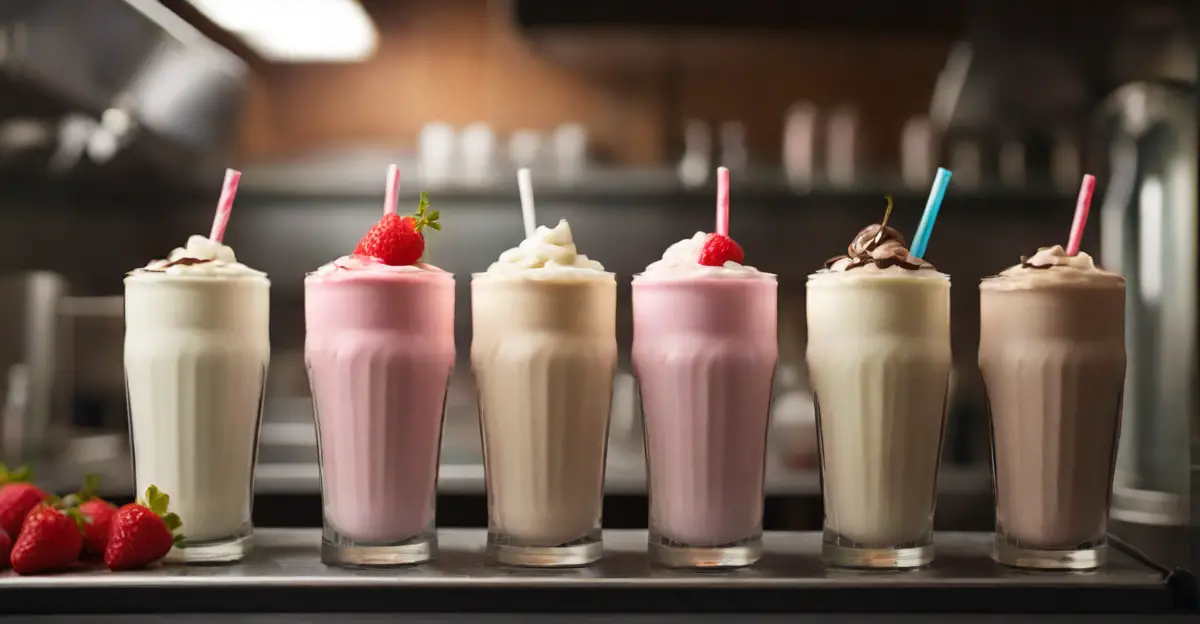As someone who occasionally indulges in the delight of a good milkshake, I’ve often wondered about the best practices for storing them. The key question is: how long can a milkshake realistically last in the fridge?
The first thing to consider is how it’s stored. To keep a milkshake fresh for as long as possible, it should be placed in an airtight container. This method prevents the milkshake from absorbing any odors and ensures its flavors stay intact. Ideally, store it in the coldest part of your refrigerator. From my personal experience, doing this helps maintain the milkshake’s quality for about 3-4 days.
However, it’s crucial to enjoy your milkshake within 24 hours of making it for the best taste and texture. Most people don’t finish an entire milkshake in one sitting, which is understandable. Therefore, knowing the best way to store it becomes essential.
Another vital aspect to consider is how to tell if a milkshake has gone bad. If you notice any changes in color, texture, or an off smell, it’s time to say goodbye to your milkshake. This information is crucial because consuming a spoiled milkshake can be unhealthy.
Remember, these guidelines are designed to help you enjoy your milkshake longer and ensure food safety. So, next time you dive in to a delicious milkshake, consider these tips for optimal enjoyment.
Ingredients Used in Milkshakes
When it comes to the shelf life of milkshakes, a crucial aspect is the ingredients used. As someone who enjoys crafting milkshakes at home, I’ve learned that what you put in your shake significantly impacts how long it can stay fresh in the fridge.
Incorporating fresh fruit or other perishable ingredients tends to shorten the lifespan of a milkshake. These ingredients do not last as long as shelf-stable ingredients. For example, a milkshake made with fresh bananas will spoil faster than one made solely with ice cream and chocolate syrup. While perishable items add freshness and flavor, they also accelerate spoilage. Conversely, using shelf-stable ingredients can extend the milkshake’s freshness.
The Impact of Sugar on Shelf Life
The amount of sugar and sweeteners added to a milkshake also plays a significant role. Although sugar can act as a preservative, it’s essential to avoid adding too much. Excess sugar can lead to a quicker spoilage of the milkshake. This is a fine balance to maintain, as too little sugar might not preserve well, and too much might spoil it quickly.
In the end, understanding the impact of various ingredients on a milkshake’s shelf life can enhance your milkshake-making and enjoying experience.
Can a Milkshake Go Bad in the Fridge?
Discussing the longevity of a milkshake in the fridge, it’s crucial to address a common query: Can a milkshake go bad? As a home chef who loves experimenting with different flavors, I’ve noticed that even in the cold confines of a fridge, a milkshake’s life is not indefinite.
Yes, unfortunately, milkshakes can go bad in the fridge. Typically, they stay fresh for only a few days. The shelf life of a milkshake is relatively short, and various factors influence it. One such factor is the initial quality and type of milk used. Whether it’s ice cream, iced milk, or plain milk, each has its own preservation properties.
Factors Affecting Milkshake’s Shelf Life
The exact shelf life will depend on several factors. These include the preparation methods and the ingredients used. A milkshake made with fruits, for instance, might not last as long as one made with just chocolate syrup and milk. Storage conditions also play a vital role. The way the milkshake is stored – whether in an airtight container or casually covered – impacts its longevity.
The Role of Ingredients in Shelf Life
Furthermore, the inclusion of certain flavorings or alcoholic beverages can alter a milkshake’s shelf life. These ingredients can either act as preservatives or, conversely, cause the milkshake to spoil more rapidly.
Each milkshake is a unique sweet, cold beverage, and its lifespan in the fridge can only be estimated. These nuances and more will be discussed in the following sections of this article.
What Determines How Fast Milkshakes Go Bad in the Fridge?
In exploring the question of a milkshake’s longevity in the fridge, it’s essential to understand what influences how fast milkshakes go bad. As someone who has spent ample time blending and tasting different milkshake concoctions, I’ve observed several key factors that determine their shelf life.
The main factors that determine how quickly a milkshake spoils include the quality of ingredients, the type of milk used, and the storage conditions.
Quality of Ingredients
The quality of ingredients in milk shakes significantly affects their lifespan. Different ingredients introduce varying levels of microorganisms, which in turn affect the shelf life. A milkshake with fresh fruits or vegetables, for example, will have a different spoilage rate compared to one made with just ice cream and syrup.
The Role of Milk in Milkshake Shelf Life
The initial microbial load of the milk used is also a critical factor. Milk with a higher population of bacteria, often found in previously-stored milk, will lead to quicker spoilage. The type of milk and how it’s processed—whether through pasteurization, sterilization, or ultra high temperature sterilization—influences its microbial content. These thermal treatments are instrumental in extending or reducing the shelf life of milkshakes.
Impact of Stabilizers and Antioxidants
Incorporating stabilizers like carrageenan or other hydrocolloids, as well as antioxidants present in fruits, can increase shelf lifes. These additives help in preserving the milkshake for a longer duration.
Thermal History of Milkshakes
The thermal history of the milkshake plays a role too. A study showed that thermally treated milkshakes had a significantly extended shelf life – up to over 50 days in the fridge – compared to an untreated one, which lasted about 18 days.
Understanding these factors can greatly aid in maximizing the enjoyment of your homemade milkshakes.
How to Properly Store Milkshakes
When it comes to enjoying a delightful milkshake for as long as possible, understanding the art of storing it correctly in the refrigerator is key.
The first step is to use airtight containers. This is crucial to prevent the milkshake from absorbing odors from other food items in the fridge, ensuring that the milkshake’s flavor remains unaltered. Not only does this method keep the milkshake fresh for longer, but it also helps in maintaining its texture and consistency. From personal experience, a milkshake stored this way can retain its taste for a surprising length of time.
Another important aspect is to label the container with the date it was made and when it should be consumed. This practice helps to ensure that the milkshake is enjoyed within a safe timeframe and is at its peak of freshness when served.
Through these simple yet effective storage techniques, you can significantly extend the life of your homemade milkshakes, keeping them delicious and safe to drink.
Signs of Spoilage
In the journey of enjoying a perfect milkshake, it’s important to be aware of the signs of spoilage, especially when storing milkshakes in the refrigerator for extended periods.
The first telltale sign is an off odor. A fresh milkshake should smell as delightful as it tastes. Any deviation from its original aroma is a clear indication that it’s time to discard it. Similarly, a change in color or an abnormal texture can signal spoilage. I’ve noticed that milkshakes tend to separate or develop a grainy texture when they start to go bad.
It’s generally advised to consume a milkshake within a week. If it has been more than one week in the refrigerator, even without visible signs of spoilage, it’s safer to discard it immediately. Consuming a spoiled milkshake can lead to foodborne illnesses, and it’s always better to err on the side of caution.
Conclusion
In the delightful world of milkshakes, understanding their lifespan in the refrigerator is crucial. These delicious and refreshing treats can last up to a week when subjected to proper storage techniques. It’s essential to use airtight containers and maintain the proper temperature in the fridge to preserve their freshness and flavor.
However, being aware of the signs of spoilage is equally important. If a milkshake has been stored for more than one week, or if any signs of spoilage are evident, it’s best to discard it promptly. This ensures not only the enjoyment of your milkshake at its best but also upholds food safety standards.
FAQs
Will a milkshake stay good in the fridge?
Yes, a milkshake can remain good in the fridge for up to a week if stored in an airtight container at a consistent, cold temperature.
How do you preserve a milkshake for a long time?
Preserve a milkshake by storing it in an airtight container in the coldest part of the fridge. Avoid adding ingredients that spoil quickly.
How long is a shake good for?
A shake is typically good for 3-4 days in the fridge, but this can vary depending on the ingredients used.
How do you revive a frozen milkshake?
To revive a frozen milkshake, let it thaw slightly at room temperature and then gently stir or blend to restore consistency.
Is it better to freeze or refrigerate milkshakes?
It’s generally better to refrigerate milkshakes. Freezing can change the texture and consistency, making it less enjoyable when thawed.

